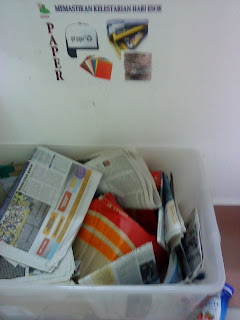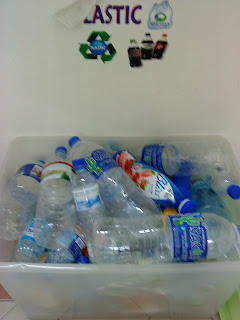We all know that waste cannot be eliminated entirely but we do can prevent waste. Waste is anything we throw away or get rid of, that doesn’t get used.
How do we do it? We do it with the 3Rs- Reduce, Reuse, Recycle.
Reduce the amount and toxicity of trash you throw away, Reuse containers and products, Recycle as much as possible and buy products with recycled content.
It’s time to link up our projects for the Reduce, Reuse, Recycle Challenge!
Before we proceed to the 3-Rs, we need to identify to re-use plastic for food packaging/storage pose some level of
danger to our health. Look around! TOXIC food packaging is everywhere.
Now by practicing all three of the 3Rs activities every day is not only important
for a healthy environment, but it can also be fun too. So let's take a
minute right now to learn more about waste and waste management, so you
can become a key player in making our world a safe and healthy place.
Reduce/Reduction: to make something smaller or use less, resulting in a smaller amount of waste.
"Source
reduction" is reducing waste before you purchase it, or by purchasing
products that are not wasteful in their packaging or use.
A
key part of waste "reduction" is "conservation"—using natural resources
wisely, and using less than usual in order avoid waste.
"Reduce" means using fewer resources in the first place. This is the most effective of the three R's and the place to begin. You don't need to let go completely or all at once. "Reduce" is a comparative word. It says: cut back from where you are now.
You
can practice reduction by selecting products that do not have to be
added to landfills or the waste stream in general. This is really easy
to do...
- First and foremost, buy and use less! Buy only what you need
and use all of what you buy. Or make sure that when you are through with
something, you pass it along to other people who can continue to put it
to good use. When
you shop, shop differently. Look for things that will last -- things
that are not just durable and well-made, but useful and beautiful enough
to please you for a long time. The extra money you spend on their
acquisition will be offset by the money you do not spend replacing them.
- Start making wise "package" selections.
Why is it important to consider how something is packaged when you
consider what to buy? You can reduce waste by selecting products that
are not wasteful in their packaging. This is especially important when it comes things that can
be dangerous to our environment, such as paint and chemicals. Precycle by purchasing products in materials/packaging that can be readily recycled.
- Refuse store bags!
When you buy one or two items at a store, carry them out in your hands;
or take a reusable bag with you to carry the items you buy. And don't
forget to take your old plastic and paper bags back to the grocery store
for reuse or recycling. Most grocery stores have convenient paper and
plastic recycling bins located near the entrance.
- You can reduce waste by using a computer! Many newspapers and
magazines are online now. Instead of buying the paper versions, you can
find them on the Internet. Also remember that you should print out only
what you need. Everything you print that you don't really need is a
waste of paper.
- Save energy by turning off lights that you are not using.

You can "reuse" materials in their original form instead of throwing
them away, or pass those materials on to others who could use them too!
Remember, one man's trash is another man's treasure! Here are some
examples of reuse...
- Take along washable cups or
travel mugs instead of disposables; a lot of restaurants and stores will
be glad to fill or refill your own mug.
- When you
do use disposables like plastic cups, plates, utensils, and plastic food
storage bags, don't throw them away! Wash and reuse them—most of them
will last for a long time with many uses. They may not cost much to
replace, but it doesn't make any more sense to throw away those things
than it does to throw away your bicycle after one use.
- Coffee cans, shoe boxes, margarine containers, and other types of
containers people throw away can be used to store things or can become
fun arts and crafts projects. Use your imagination!
- Don't throw out clothes, toys, furniture, and other things that you
don't want anymore. Somebody else can probably use them. You can bring
them to a center that collects donations, give them to friends, or even
have a yard sale.
- Use all writing paper on both sides.
Before
you recycle or dispose of anything, consider whether it has life left
in it. A jam jar can store leftovers. Food scraps can become compost. An
old shirt can become a pajama top. An opened envelope can become a
shopping list. A magazine can be shared. DVDs can be traded. A
dishwasher can be repaired. A computer can be upgraded. A car can be
resold. A cell phone can be donated. Returnable bottles can be, well...
returned.
Reusing keeps new resources from being used for a while longer, and old
resources from entering the waste stream. It's as important as it is
unglamorous. Think about how you can do it more.
Recycling
is the "R" that has caught on the best. Partly, this is because there
are so many recycling programs today which makes recycling so easy.You just have to start doing it!
Recycling turns materials that would otherwise become waste into
valuable resources. Collecting used bottles, cans, and newspapers and
taking them to the curb or to a collection facility is just the first in
a series of steps
that generates a host of financial, environmental, and social returns.
Some of these benefits accrue locally as well as globally.
Many of the things we use every day, like paper bags, soda cans, and
milk cartons, are made out of materials that can be recycled. Recycled
items are put through a process that makes it possible to create new
products out of the materials from the old ones.
In addition to recycling the things you buy, you can help the
environment by buying products that contain recycled materials. Many
brands of paper towels, garbage bags, greeting cards, and toilet paper, to
name a few examples, will tell you on their labels if they are made from
recycled materials.
In some towns you can leave your recyclables in bins outside your home,
and a truck will come and collect them regularly. Other towns have
recycling centers where you can drop off the materials you've collected.
Things like paper and plastic grocery bags, and plastic and aluminum cans
and bottles can often be brought to the grocery store for recycling.
Whatever your system is, it's important to remember to rinse out and sort
your recyclables!

























